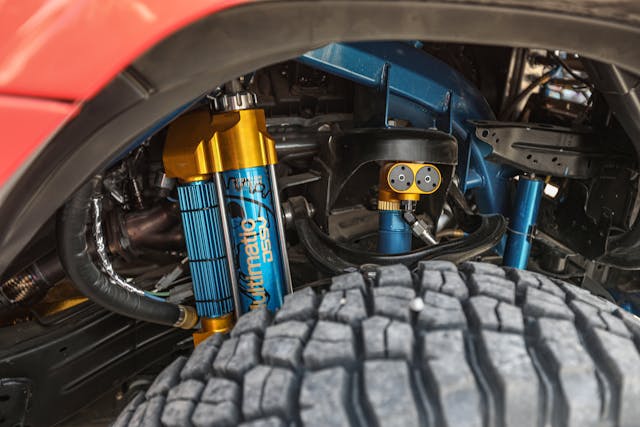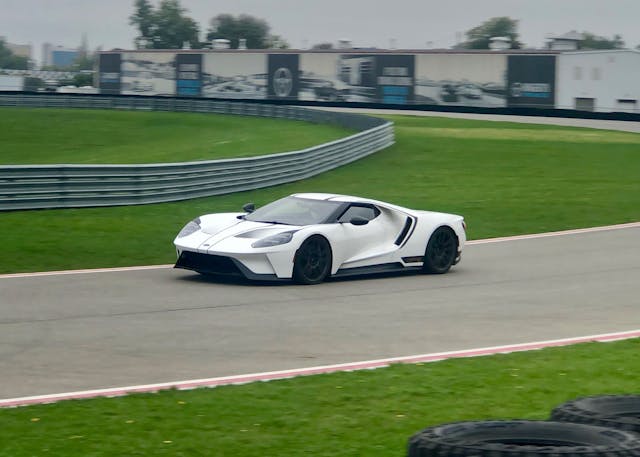Media | Articles
Multimatic’s newest spool-valve dampers feel like absolute witchcraft
Driving any Ford GT for the first time carries some responsibility, because the last thing you want to do is put a wheel wrong and bend the thing. Not that carbon-fiber can be bent, of course, but this is one car you don’t want to wreck. Knocking a corner off a $500,000 vehicle like this is a career-ending move. Factor in the unfamiliarity of the vehicle on top of a new-to-you racing circuit, and you’ve got a long list of anxiety-inducing reasons to stay in bed that day.
When you learn you’ll be driving a Ford GT that has been used by a world-renowned motorsports tech company for a full range of development work—and, as such, is essentially priceless—you’ve got all the excuses in the world to stay hidden under the synthetic duvet of your mid-priced chain hotel.
The folks at Multimatic invited me to try a unique specification of one of their GT development mules at Pontiac, Michigan’s M1 Concourse. I’m always up for a driving challenge, but even after I summoned my courage and promised to attend, as the date approached, the butterflies in my stomach increased exponentially.
Multimatic is a Canadian-headquartered supplier to the automotive industry that produces everything from small components to sophisticated systems. The company also assembles the Ford GT on the Blue Oval’s behalf in a nondescript industrial building outside of Toronto, Ontario—but if you assume that Multimatic’s products are similarly run-of-the-mill, you’re far off the mark indeed.
Among many of the car’s systems, Multimatic engineered the GT’s double-wishbone pushrod suspension to effectively have two completely different setups—a standard mode for road driving as well as a dedicated track mode that not only lowers the car but also increases spring and damping rates. Think about it this way: The GT has two completely different suspensions. That’s simply unheard of in the world of supercars.
Marketplace
Buy and sell classics with confidence

In motorsports, Multimatic supports the Mazda RT-24P in the IMSA WeatherTech Sportscar Championship. The company also produces its trick spool-valve dampers for a range of racing applications, like the spec units in the Porsche 992 GT3 Cup cars as well bespoke pieces for several Formula 1 teams.

Most car enthusiasts know Multimatic best for its gold-and-blue spool-valve dampers used in focused applications like the Chevy Colorado ZR2 and Camaro ZL1 1LE. When I drove its DSSV dampers for the first time in the Camaro Z/28, I began a proper education in shock technology and it hasn’t stopped. I’m just a dumb racing driver and certainly no mechanical engineer, but every time I look into Multimatic’s offerings, I leave a little smarter.

The thing about spool-valve dampers is that they are inherently good at delivering predictable force-velocity curves across all operating conditions. Even when carefully assembled, the typical shim-stack style damper has too much variation from one careful build to another to be as reliable and as consistent as a spool-valve damper.
Spool valves have been used in aerospace and industrial applications for a long time—anywhere precise fluid flow is required, essentially—and when Multimatic introduced the technology to motorsport dampers, it brought a fundamental shift in race car engineering. Previously a black art, shock engineers would build (and some still do) a range of shocks, throw them on a dynamometer, and record their characteristics for use at a particular circuit. Now, using DSSVs, race engineers can simply specify precise force-velocity curves and have the dampers assembled with the corresponding spool valve hardware, eliminating any trial and error. As you’d expect, Multimatic holds several patents on the tech.

Given that the company is Canadian, it’s also no surprise that it’s quietly going about business and has maintained an understated image. Part of that is its exclusive clientele: Unless you’re buying a racing car like the Ford Mustang GT4, the Ford GT Mk II track car, or the new Bronco DR off-road racer, you can’t do business with Multimatic. Even if you’ve got very deep pockets and consider contacting the company, you’re as likely to do business with it as you are to win the Formula 1 World Championship.
Recently, Aston Martin announced details of its upcoming Valhalla. Buried in the Gaydon press release were a few words about an adaptive version of Multimatic’s spool-valve dampers, a core component of the near 1000-horsepower hybrid hypercar’s suspension.

While the Valhalla won’t hit the road for another year or two, the reason Multimatic invited me to drive its GT was that it’s fitted this car with a set of proprietary adaptive spool-valve (ASV) dampers. Although these ASV dampers won’t hit production lines for a while, Multimatic is confident that they’re ready for primetime and was willing to let me drive the damping tech of the future.
Murray White’s title—Technical Director of Vehicle Dynamics—is a fancy way of saying he’s quite good at feeling the qualities of a car’s handling and interpreting that in a way that can be used to optimize the suspension calibrations of said car. In colloquial terms, he’s the man with the golden arse.
Mr. White was the unlucky soul chosen to accompany me in the GT onto the M1 circuit. While we had never met, I’d committed the cardinal sin of automotive media: I’d walked into the garage with my helmet bag and racing boots. I’m sure he quietly muttered the word “punter” to himself at some point that morning.
Before we rolled out onto the track, White explained I’d have six damper modes to choose from—passive and adaptive normal, passive and adaptive sport, and passive and adaptive track. When I asked how the basic suspension calibrations differed from those on the standard GT, White told me that spring rates were set 15 percent softer than those of the production car.
For the first few laps, I rolled the GT around in passive-normal mode just to get a sense of braking, turn-in, apex, and exit points, gradually increasing my pace. To be fair, M1’s compact layout was a bit tight for the long-legged Ford supercar.
After switching to adaptive-normal, I found that the GT cornered, accelerated, and braked a little flatter than in the passive mode, but after a few more laps comparing passive-sport and adaptive-sport modes, the difference became clear. In adaptive-sport, turn-in response was quicker, the GT cornered with noticeably less body roll, and there was far less dive when I hit the brakes. Even exiting corners, the GT allowed me to get more aggressive with the throttle.
As a driver, I had much more confidence in adaptive-sport to explore the GT’s dynamics further towards its limits. The car was encouraging me to drive faster. For a brief moment, I realized that this is the quickest road car I’ve ever driven on track—but here it was, goading me to pick up my pace. The feedback I was getting from the chassis and the tire contact patches was high-fidelity and felt completely natural.
In adaptive mode, the system operates at 1000Hz, adjusting damping rates a thousand times a second. How the damper works, however, is unlike the adaptive magnetorheological shocks we’re accustomed to in modern cars (think GM’s MagneRide). Instead of varying damper-fluid viscosity, Multimatic’s ASV dampers adjust the valve itself, which affects the rate at which the damper fluid will flow through it.

If you’ve seen the internals of a spool-valve damper, you’ll notice the precision with which the spool valves themselves are machined. Multimatic’s adaptive version expands upon that idea by adding a collar or ring with precisely cut windows that rotates around the spool valve and masks it in order to adjust damping rates in real time.
The result is a spool-valve damper with 16 distinct force-velocity curves for compression and rebound that is capable of changing damping rates incredibly quickly. According to Multimatic, they can switch from full soft to full stiff—and vice versa—in fifteen milliseconds, with a typical response time of just six milliseconds, which is completely imperceptible to mere mortals. Each damper has an integrated accelerometer and that movement data is sent to the controller.
One of the benefits of a spool valve damper is its low-pressure design, which helps it operate at cooler temperatures than traditional dampers. The cooler the shock runs, the cooler the damper fluid remains, and that delivers consistent performance, particularly in more extreme operating environments like the race track.
In the case of this adaptive version, the same principles apply. The ASV remains a low-pressure design and the addition of the slotted collar allows wide-ranging and highly precise control of fluid flow. Where a magnetorheological design changes the viscosity of the damper fluid, the ASV changes the valving. The end result is an adaptive unit that feels more natural to the driver, according to White.
After switching to the GT’s famous track mode—the one where the car drops a couple of centimeters in the blink of an eye—I had a few laps remaining to explore passive and adaptive track modes. If you recall, spring rates also double in track mode and damping rates change to suit.
To be fair, I still need a few more laps in the GT to completely discover a difference between the passive and adaptive damping rates in track mode. Admittedly, I could feel only the slightest difference at a couple of points around the circuit while in the two track modes, which is directly attributable to the pace at which I was running.
With another ten minutes in this priceless Ford supercar, I’m certain I’d have figured out the adaptive mode, but there were several engineers expecting to get behind the wheel and I wasn’t prepared to ruin their day. Plus, no matter how quickly I went, Multimatic wasn’t going to offer me a contract to race one of its Mustang GT4s next season.
After I left the circuit, I marveled at the differences between the passive and adaptive sport modes. It was unlike anything I’d experienced and while it’s challenging for me to describe ASVs as feeling as natural as a dialed-in passive damper, as White does, if I look at it from the perspective of speed, it certainly does.
These dampers dramatically changed the handling behavior of the GT without any downside. Set to adaptive, the Ford cornered flatter, was more stable under braking, allowed me to accelerate out of corners sooner than in the passive mode, and do so with better chassis feel and more confidence.

In that context, I think White is right. I clearly remember a recent drive of the new Cadillac CT5-V Blackwing; its advanced magnetorheological shocks were quite good, but I’d describe their operation as somewhat digital. That damper technology has become quite sophisticated and the processing power that underpins it is formidable, which permits rapid changes in effective damping rates. To be clear, I was still able to drive the Caddy quickly, but from the outside, the car’s body language also displayed some subtle, high-frequency adjustments, as if the chassis were reacting against the dampers. As good as these magnetorheological units are, the feeling isn’t as natural as that of Multimatic’s ASVs.
Undoubtedly, these ASV dampers will be priced dearly, but I suspect we’ll begin to see them on vehicles other than low-volume exotics like the Aston Martin Valhalla in the near future. As a racer, that’s an unusual place to find yourself because there are always tradeoffs and compromises when you make setup changes, but in the case of this GT with its dampers from the future, it’s like I had the best of all worlds.
Most of all, I’m glad I didn’t wreck that irreplaceable Ford GT.


















